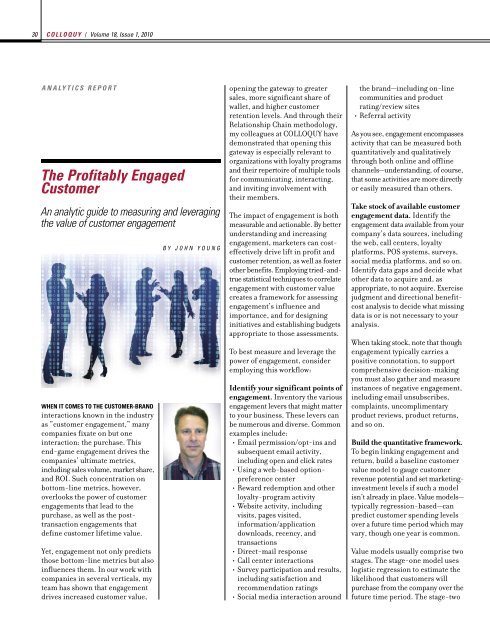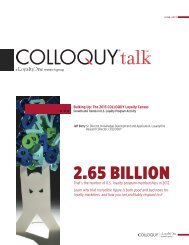Transformers - Colloquy
Transformers - Colloquy
Transformers - Colloquy
You also want an ePaper? Increase the reach of your titles
YUMPU automatically turns print PDFs into web optimized ePapers that Google loves.
30<br />
C O L L O Q U Y / Volume 18, Issue 1, 2010<br />
A N A LY T I C S R E P O R T<br />
The Profitably Engaged<br />
Customer<br />
An analytic guide to measuring and leveraging<br />
the value of customer engagement<br />
WHEN IT COMES TO THE CUSTOMER-BRAND<br />
interactions known in the industry<br />
as “customer engagement,” many<br />
companies fixate on but one<br />
interaction: the purchase. This<br />
end-game engagement drives the<br />
companies’ ultimate metrics,<br />
including sales volume, market share,<br />
and ROI. Such concentration on<br />
bottom-line metrics, however,<br />
overlooks the power of customer<br />
engagements that lead to the<br />
purchase, as well as the posttransaction<br />
engagements that<br />
define customer lifetime value.<br />
Yet, engagement not only predicts<br />
those bottom-line metrics but also<br />
influences them. In our work with<br />
companies in several verticals, my<br />
team has shown that engagement<br />
drives increased customer value,<br />
B Y J O H N Y O U N G<br />
opening the gateway to greater<br />
sales, more significant share of<br />
wallet, and higher customer<br />
retention levels. And through their<br />
Relationship Chain methodology,<br />
my colleagues at COLLOQUY have<br />
demonstrated that opening this<br />
gateway is especially relevant to<br />
organizations with loyalty programs<br />
and their repertoire of multiple tools<br />
for communicating, interacting,<br />
and inviting involvement with<br />
their members.<br />
The impact of engagement is both<br />
measurable and actionable. By better<br />
understanding and increasing<br />
engagement, marketers can costeffectively<br />
drive lift in profit and<br />
customer retention, as well as foster<br />
other benefits. Employing tried-andtrue<br />
statistical techniques to correlate<br />
engagement with customer value<br />
creates a framework for assessing<br />
engagement’s influence and<br />
importance, and for designing<br />
initiatives and establishing budgets<br />
appropriate to those assessments.<br />
To best measure and leverage the<br />
power of engagement, consider<br />
employing this workflow:<br />
Identify your significant points of<br />
engagement. Inventory the various<br />
engagement levers that might matter<br />
to your business. These levers can<br />
be numerous and diverse. Common<br />
examples include:<br />
• Email permission/opt-ins and<br />
subsequent email activity,<br />
including open and click rates<br />
• Using a web-based optionpreference<br />
center<br />
• Reward redemption and other<br />
loyalty-program activity<br />
• Website activity, including<br />
visits, pages visited,<br />
information/application<br />
downloads, recency, and<br />
transactions<br />
• Direct-mail response<br />
• Call center interactions<br />
• Survey participation and results,<br />
including satisfaction and<br />
recommendation ratings<br />
• Social media interaction around<br />
the brand—including on-line<br />
communities and product<br />
rating/review sites<br />
• Referral activity<br />
As you see, engagement encompasses<br />
activity that can be measured both<br />
quantitatively and qualitatively<br />
through both online and offline<br />
channels—understanding, of course,<br />
that some activities are more directly<br />
or easily measured than others.<br />
Take stock of available customer<br />
engagement data. Identify the<br />
engagement data available from your<br />
company’s data sources, including<br />
the web, call centers, loyalty<br />
platforms, POS systems, surveys,<br />
social media platforms, and so on.<br />
Identify data gaps and decide what<br />
other data to acquire and, as<br />
appropriate, to not acquire. Exercise<br />
judgment and directional benefitcost<br />
analysis to decide what missing<br />
data is or is not necessary to your<br />
analysis.<br />
When taking stock, note that though<br />
engagement typically carries a<br />
positive connotation, to support<br />
comprehensive decision-making<br />
you must also gather and measure<br />
instances of negative engagement,<br />
including email unsubscribes,<br />
complaints, uncomplimentary<br />
product reviews, product returns,<br />
and so on.<br />
Build the quantitative framework.<br />
To begin linking engagement and<br />
return, build a baseline customer<br />
value model to gauge customer<br />
revenue potential and set marketinginvestment<br />
levels if such a model<br />
isn’t already in place. Value models—<br />
typically regression-based—can<br />
predict customer spending levels<br />
over a future time period which may<br />
vary, though one year is common.<br />
Value models usually comprise two<br />
stages. The stage-one model uses<br />
logistic regression to estimate the<br />
likelihood that customers will<br />
purchase from the company over the<br />
future time period. The stage-two




